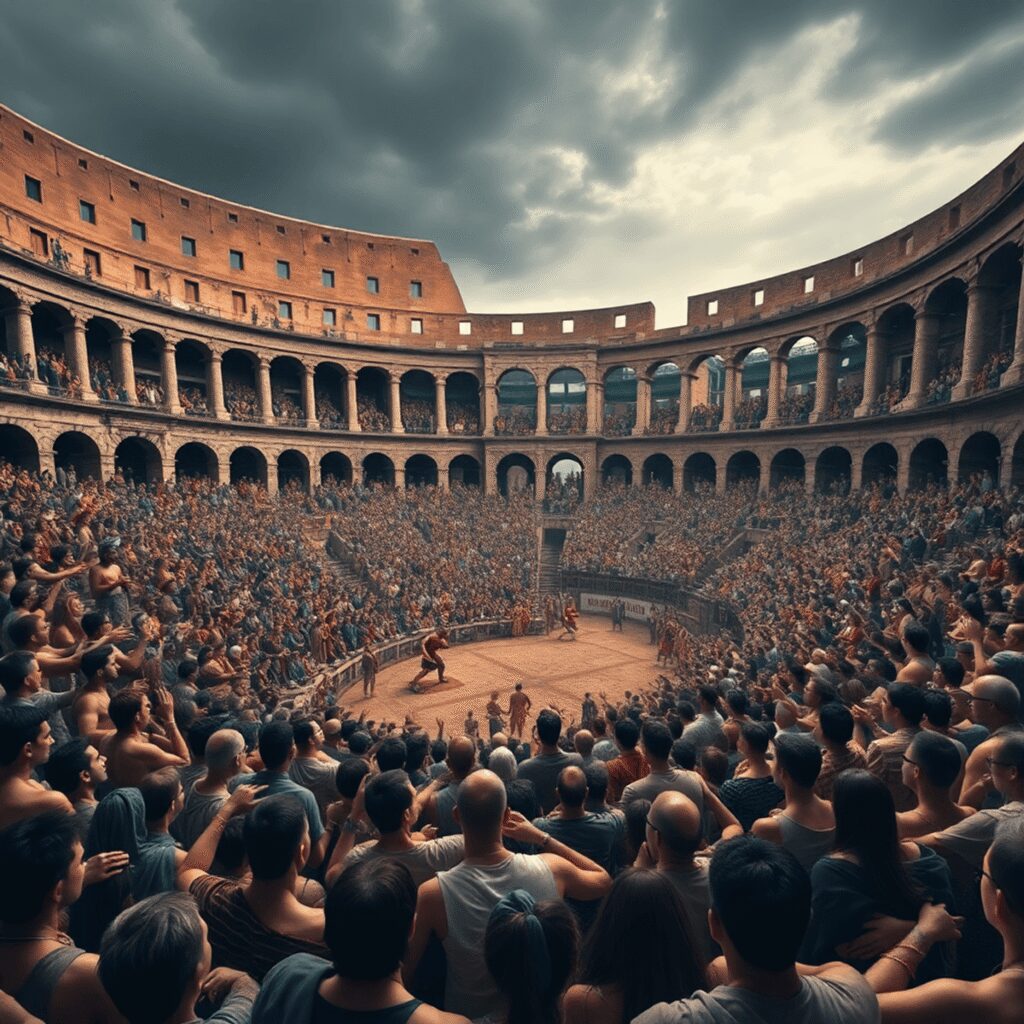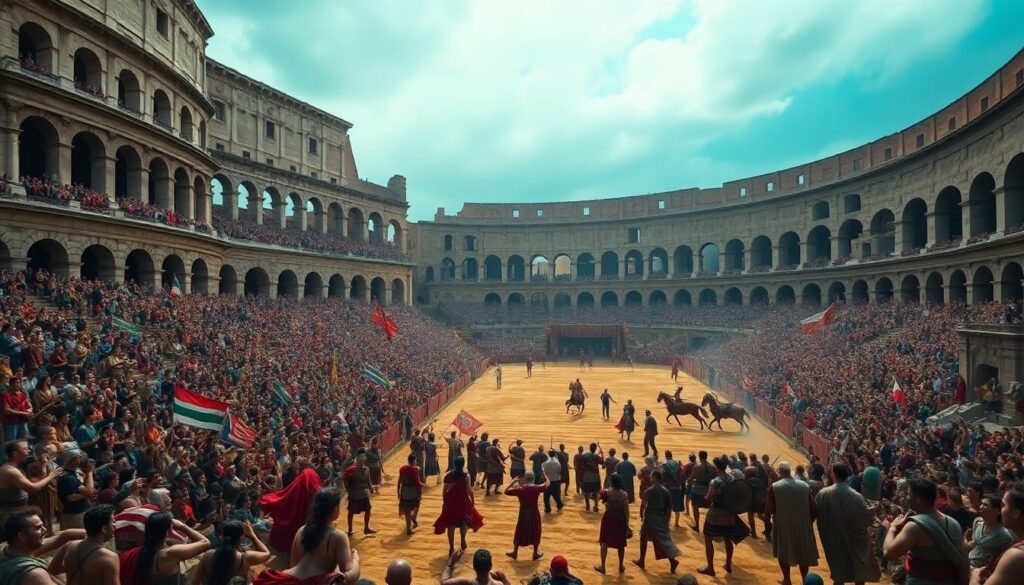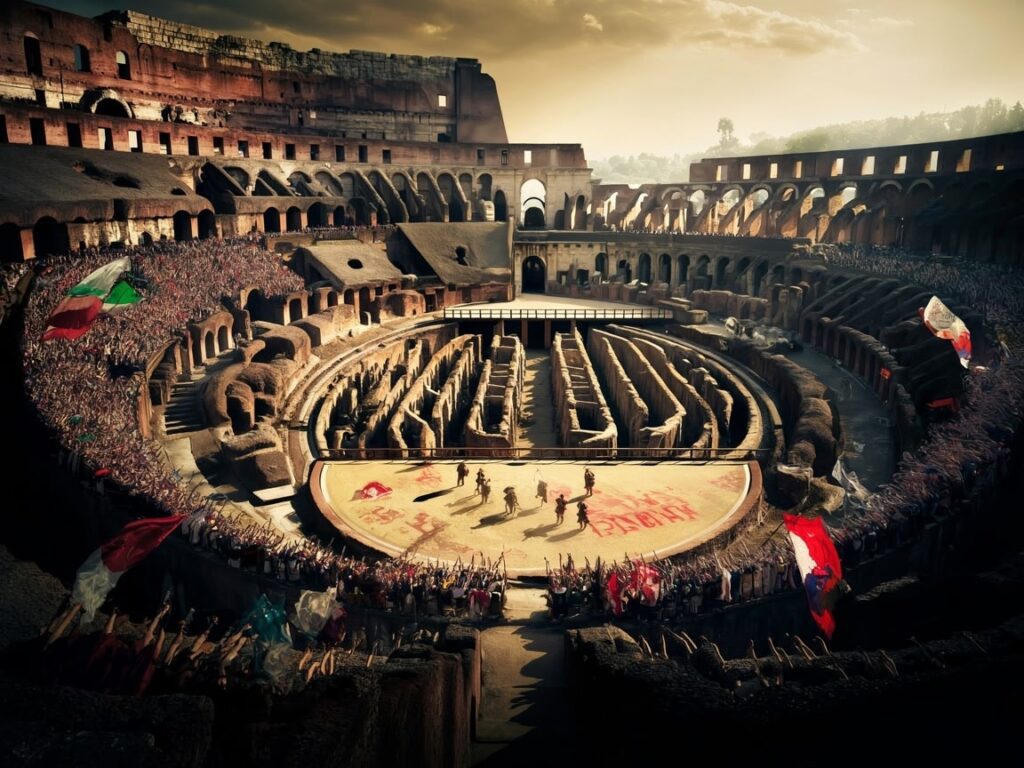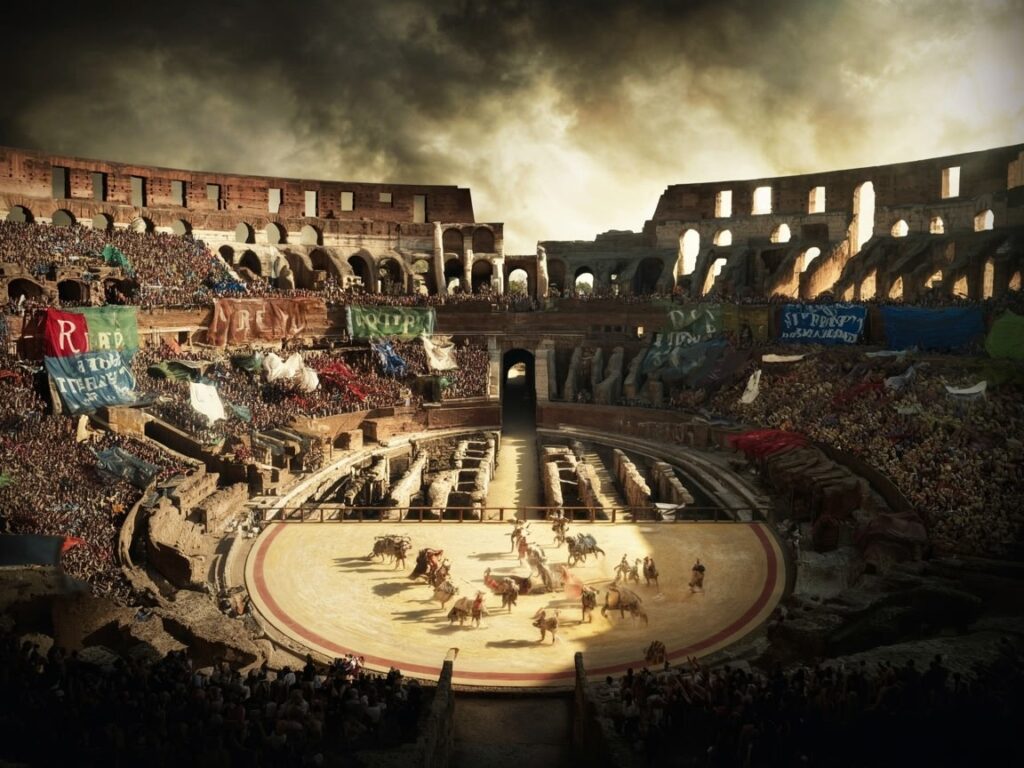Sports Fans in the Colosseum: Ancient Hooliganism Explained reveals a side of ancient Rome often overshadowed by its architectural marvels and political history—the intense and sometimes violent passion of its sports fans. Sports fans in ancient Rome were not mere spectators; they were active participants whose emotions and loyalties shaped the atmosphere of public games.
The Colosseum, an iconic symbol of Roman engineering, was the epicenter for gladiatorial contests and other spectacles that captivated thousands. This massive amphitheater was more than just a venue; it was a cultural hub where social status, politics, and entertainment intersected. Holding up to 50,000 spectators, it hosted brutal games that stirred fierce devotion among fans.
Ancient hooliganism manifested vividly during these events. Fan rivalries often escalated beyond cheers to aggressive confrontations, reflecting deep-seated social tensions. The term “ancient hooliganism” captures this phenomenon of rowdy, sometimes violent support that parallels modern-day sports fanaticism. Understanding these behaviors provides insight into how sports fandom has long been intertwined with identity, community, and conflict—an aspect still relevant when examining today’s fan cultures.

Gladiatorial Games: The Ultimate Spectacle
Gladiatorial combat stood at the heart of Roman entertainment, captivating a vast audience across social classes. These contests were more than mere fights; they were ritualized battles that showcased skill, bravery, and endurance. Gladiator fans flocked to arenas craving the thrill of life-or-death struggles, where fighters—often slaves, prisoners of war, or volunteers—engaged in brutal duels.
The Colosseum: Epicenter of the Games
The Colosseum served as the primary venue for these spectacles. This iconic amphitheater could accommodate tens of thousands of spectators who gathered to witness matches that combined athleticism with theatrical drama. Its architectural grandeur amplified the intensity of each event, creating an electric atmosphere charged with anticipation and emotion.
Why Gladiatorial Games Were So Popular
Key features that made gladiatorial games wildly popular:
- Varied combat styles: Different types of gladiators specialized in unique weapons and armor, adding diversity and excitement to the contests.
- Public spectacle and social ritual: Emperors used games to display power and generosity, while fans expressed loyalty by vocally supporting their favorite fighters.
- High stakes: The threat of death or mercy decisions by the crowd raised tension and emotional investment among spectators.
Gladiator fans identified deeply with their champions. Their enthusiasm often manifested in vocal support, betting, and intense rivalries—all contributing to a fan culture that was passionate and sometimes volatile.

The Passionate Support for Gladiators
Devotion to fighters in ancient Rome went far beyond casual interest. Fans developed intense loyalty toward their favorite gladiators, often following their careers with great enthusiasm. This passionate support was visible in multiple ways:
1. Personal Connections
Gladiators sometimes originated from specific regions or cities, creating a sense of local pride among spectators who cheered them on as representatives of their hometowns.
2. Symbolic Identity
Gladiators were branded with distinctive names, armor styles, or fighting techniques that made them memorable and relatable to the crowd.
3. Social Interaction
Fans discussed gladiatorial battles eagerly in communal spaces like taverns, sharing information about victories, defeats, and upcoming matches.
The emotional investment was not merely about entertainment. For many Romans, supporting a gladiator meant aligning with a cause or identity that transcended the arena. Some spectators believed their favored fighters embodied virtues such as courage and honor. Others felt personal attachment because they admired the gladiator’s skill or physical prowess.
Graffiti found in cities like Pompeii reveals detailed knowledge about individual gladiators’ schools and fight records, showing how deeply fans followed their careers. This dedication created an environment where devotion to fighters sometimes sparked intense competition between different fan groups, setting the stage for eruptions of violence during events.

Violence and Rivalry Among Gladiator Fans
The intense atmosphere of gladiatorial matches often fueled violent reactions among spectators, with emotions running high and competition between different factions escalating into physical altercations. This passionate support for favored gladiators sometimes crossed the line into aggressive behavior, leading to instances of riots and disturbances within the Colosseum and other arenas. Here are some examples of the tumultuous events that unfolded due to heated rivalries among fan groups:
- Pompeii Riot: After a contentious fight between local gladiator teams, a riot erupted in Pompeii, resulting in the banning of games due to the level of violence and chaos.
- Faction Clashes: Different factions of supporters, known for their unwavering loyalty to specific gladiators or teams, often clashed both inside and outside the arenas, turning what was supposed to be entertainment into scenes of conflict.
- Violent Outbursts: Spectators would sometimes engage in physical confrontations with fans supporting opposing factions, leading to injuries and disturbances that overshadowed the sporting events.
The competitive nature of gladiatorial combat combined with the tribalistic fervor of fan groups created a volatile environment where clashes were not uncommon. The legacy of ancient hooliganism in the Colosseum serves as a stark reminder of how unchecked passion can spiral into violence and disorder in the pursuit of sporting glory.
The Role of Elite Spectators and Roman Women in Fan Culture
The gladiatorial games attracted a wide social spectrum, but elite spectators and Roman women’s involvement added unique dimensions to fan culture.
The Influence of Wealthy Elites
Wealthy elites were not merely passive observers; they often acted as patrons who sponsored gladiators or entire troupes. This patronage served multiple purposes:
- Social prestige: Supporting popular fighters elevated an elite’s status among peers.
- Political leverage: Aligning with favored gladiators could curry favor with the masses, useful during elections or power struggles.
- Personal enjoyment: Many elites relished the spectacle and engaged in betting on outcomes.
Breaking Gender Norms: Roman Women’s Participation
Roman women’s participation in these events challenged traditional gender expectations. Far from being mere chaperones or casual attendees, women actively cheered their favorite gladiators, sometimes favoring certain fighters based on appearance, skill, or personal connections. Evidence from graffiti and literary sources reveals that women voiced opinions on fights and even influenced public sentiment. Some women were known to attend regularly, demonstrating enthusiasm equal to men.
A Dynamic Fan Culture
This passionate involvement by both elites and women contributed to a vibrant fan culture where gladiatorial contests were more than just blood sport—they became social events where identity, influence, and emotion intertwined deeply. The active engagement of these groups helped fuel the intense atmosphere within the Colosseum’s walls.

Chariot Racing: A Thrilling Alternative Sport
Chariot racing was one of the most exciting and popular forms of entertainment in ancient Rome. Unlike the gladiatorial games where fighters battled each other, chariot races featured fast-paced competition that attracted large crowds eager for excitement and spectacle.
The Circus Maximus: Home of Chariot Racing
The legendary arena where these races took place was known as the Circus Maximus. This massive stadium had a seating capacity of approximately 150,000 to 250,000 spectators, making it the largest sports venue in Rome. Its immense size reflected the widespread popularity of chariot racing among Romans from all walks of life.
Features of the Circus Maximus
- Elongated oval track
- Central barrier called the spina
- Monuments and turning posts challenging drivers’ skill and bravery
The Atmosphere of Chariot Races
The sound of thousands of enthusiastic fans echoed through the stands as teams raced closely around the circuit. Supporters were deeply invested in their favorite chariot factions, which were primarily divided into four colors: Reds, Whites, Greens, and Blues. These teams represented more than just sports clubs; they embodied social identities and rivalries that extended beyond the racetrack.
The Role of Circus Maximus in Roman Society
The Circus Maximus was not only a venue for athletic competition but also a vibrant hub of Roman social life. Here, loyalty and passion overflowed into everyday interactions, creating a sense of community among supporters.
The Appeal of Chariot Racing
Chariot racing combined elements of speed, danger, and loyalty to specific factions, making it an exhilarating alternative to gladiatorial combat. This unique blend secured its position as a fundamental aspect of ancient Roman popular culture.
Team Loyalty and Fierce Rivalries on the Racetrack
Passionate Allegiance to Teams
Chariot racing in ancient Rome was not just about the sport itself; it became a matter of fierce loyalty to specific chariot teams. Fans identified strongly with their chosen faction, often aligning themselves based on factors like regional affiliations or personal connections to the charioteers. This passionate allegiance to teams was a hallmark of the sport.
Intense Rivalries
The rivalries between different factions, such as the Reds, Whites, Greens, and Blues, were legendary and often escalated into violent clashes during races. These intense competitions went beyond mere sporting events; they were deeply ingrained in the social fabric of Roman society, with supporters fiercely defending the honor and success of their favored teams. The dynamics of these rivalries were further complicated by the relationships between charioteers, factions, and spectators, making each race a spectacle of not just speed but also deep-seated emotions and allegiances.

Wealthy Sponsors and Imperial Favoritism in Chariot Racing
Chariot racing in ancient Rome was not just a popular sport; it was also a platform for social climbing and political maneuvering. Wealthy sponsors played a crucial role in this dynamic by financially backing specific chariot teams. Their investment went beyond mere entertainment — it was a calculated move to increase their visibility and prestige within Roman society.
Key aspects of wealthy sponsorship included:
- Social Status Enhancement: Sponsoring a chariot team allowed affluent individuals to showcase their wealth publicly. The spectacle of lavishly outfitted horses, high-quality equipment, and well-trained drivers reflected the sponsor’s resources and taste.
- Political Influence: Backers often used their association with successful teams to curry favor with the public or political elites. Victories on the track translated into popularity off it, helping sponsors gain votes or secure important alliances.
- Imperial Connections: Some emperors openly favored certain factions, such as Emperor Vitellius’s support for the Blues. This imperial favoritism amplified the stakes for sponsors, as aligning with an emperor-backed team could yield direct benefits like political appointments or protection.
- Investment in Team Success: Wealthy patrons funded training facilities, recruited skilled charioteers, and maintained horses at peak condition. Their involvement was hands-on, demonstrating how financial power shaped competitive outcomes.
This intertwining of money, politics, and sport highlights how chariot racing transcended simple entertainment to become a significant arena for influence in ancient Rome.
Notable Incidents: From Riots to Political Unrest
Ancient sports fan violence sometimes escalated far beyond the arena, sparking large-scale riots and political upheaval. The most infamous example is the Nika Riots of 532 AD in Constantinople during Emperor Justinian I’s reign.
The Nika Riots: A Closer Look
- Originated from tensions between two dominant chariot racing factions: the Blues and the Greens.
- What began as a dispute at the Hippodrome quickly spiraled into widespread violence engulfing the city.
- Fans united against imperial authority, using the chaos to express broader discontent with Justinian’s rule.
- The riots lasted nearly a week, resulting in destruction of property, numerous deaths (estimates reach around 30,000), and near overthrow of the emperor.
This event illustrates how deeply intertwined sports fanaticism was with political and social unrest. Chariot teams were not mere entertainment but symbols of identity and power struggles. The Nika Riots reveal that fan loyalty could mobilize massive crowds capable of challenging imperial control.
Other recorded incidents across the Roman Empire show similar patterns where gladiatorial or racing rivalries triggered violent disturbances. These outbreaks highlight how fervent support for teams or fighters sometimes crossed into dangerous territory, affecting public order and forcing authorities to intervene with harsh measures.
Fan violence in ancient Rome was never just about sport; it reflected underlying societal tensions, making arenas stages for conflict far beyond mere competition.
Comparing Ancient Roman Hooliganism with Modern-Day Fanaticism
The fanaticism of sports fans in the Colosseum shares striking similarities with modern-day football hooliganism. Both ancient and contemporary supporters demonstrate an intense emotional investment in their teams or fighters, often crossing the line into violence and disorder.
Key similarities include:
Tribal Allegiance: Just as Roman fans rallied behind gladiators or chariot racing teams (like the Reds and Blues), modern fans align themselves strongly with clubs, creating fierce rivalries that can escalate beyond the stadium.
Violent Outbursts: Ancient spectators frequently resorted to physical confrontations during events, similar to how some football matches today erupt in fights between fan groups or against authorities.
Social Identity: In both eras, sports fandom acts as a marker of social belonging. Roman factions often reflected regional or class identities, just as football fan bases today may express cultural or neighborhood pride.
Political Influence: Wealthy patrons and political figures historically manipulated fan loyalty for power, seen in emperors backing certain teams. Modern sports also witness political undertones influencing fan behavior and team affiliations.
Public Disorder: Incidents like the Nika Riots reveal how sports-related fanaticism can trigger widespread civil unrest, echoing violent riots following major contemporary football matches worldwide.
This comparison highlights that fanaticism transcends time, rooted deeply in human nature’s need for community, identity, and emotional outlet through sport. Understanding these shared patterns enriches our grasp of both ancient spectacles and today’s passionate fan cultures.
Conclusion
Understanding ancient sports fans sheds light on the deep roots of our modern-day obsession with sports. The passion, loyalty, and sometimes violent fanaticism seen in the Colosseum and Circus Maximus reveal how sporting events have long served as outlets for social identity, political expression, and communal excitement. These ancient behaviors mirror many aspects of contemporary fan culture, showing that intense emotional investment in sports is not a recent phenomenon but part of a longstanding human tradition.
Exploring Sports Fans in the Colosseum: Ancient Hooliganism Explained invites you to appreciate how history informs present-day sports dynamics. Insights from this topic encourage reflection on why fans become so devoted and sometimes unruly, highlighting the social forces behind these actions.
For those eager to dive deeper into this fascinating subject, consider these resources:
- Books: “Gladiators: Violence and Spectacle in Ancient Rome” by Roger Dunkle; “Chariot Racing in the Roman Empire” by John H. Humphrey
- Documentaries: Rome’s Bloody Spectacles (History Channel); The Last Gladiators (BBC)
- Articles and Museums: Visit online collections featuring Pompeii graffiti and Roman arena artifacts to see firsthand evidence of ancient fan culture.
Engaging with these materials enriches your understanding of both ancient and modern sports fandom—illuminating how the echoes of ancient hooliganism still resonate in stadiums worldwide today.

